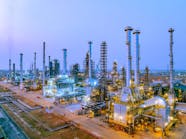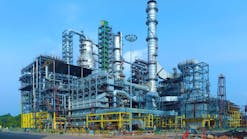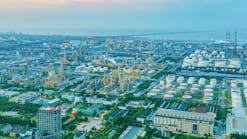Enrique Aguilar-Rodriguez, Jorge Ancheyta-Juarez Instituto Mexicano del Petroleo Mexico City
A mathematical model has been devised to represent the process that takes place in a fixed-bed, tubular, adiabatic catalytic reforming reactor.
The model, based on pilot plant data, was described in an earlier article (OGJ, Jan. 31, p. 94).
Since its development, the model has been applied to the simulation of a commercial semiregenerative reformer. The development of mass and energy balances for this reformer led to a model that predicts both concentration and temperature profiles along the reactor.
A comparison of the model's results with experimental data illustrates its accuracy at predicting product profiles. Simple steps show how the model can be applied to simulate any fixed-bed catalytic reformer.
CATALYTIC REFORMING
The catalytic reforming process is one of the refinery's most important because it produces a major portion of the gasoline pool. Reforming occurs in fixed-bed catalytic reactors, where low-octane, straight-run hydrotreated naphtha is processed to obtain higher-octane gasoline.
Reforming reactions occur at mild temperatures (700-8000 K., or 800-9800 F.) and moderately high pressures (75-500 psig), in the presence of hydrogen, to inhibit coke formation. A number of reactions take place, including aromatization, hydrocracking, cyclization, and coking.
Because of the variety of reactions, mathematical modeling of the process requires that some typical reactions be lumped to simplify the solution. At the same time enough reaction varieties must be maintained to predict the behavior of different reactor types (semiregenerative or continuous) satisfactorily under a wide range of process variables.
Reforming usually takes place in three stages using fixed-bed catalytic reactors. A mixture of hydrocarbons and hydrogen is introduced to these reactors, and the reactions occur in a quasi-adiabatic mode.
Because reforming reactions are, overall, endothermic, heat must be added to the effluent of each bed, before it is fed to the following reactor, to maintain the required inlet temperature.
A number of products are produced by reforming reactions, and effluent composition determines both fuel quality and its environmental impact, caused by the presence of components that react in the atmosphere. Mathematical modeling of the reactor, therefore, is necessary to attain proper process design and adequate prediction of the material and energy balance under different operating conditions.
The mathematical model equations result from the application of material and energy balance principles in a differential control volume. This, in turn, leads to a set of ordinary, first-order differential equations that must be solved using numerical techniques to obtain concentration and temperature profiles along the reactor.
MATHEMATICAL MODEL
The kinetic model used in this work has been reported by Ancheyta and Aguilar (OGJ, Jan. 31 , p. 94). 1 The model is based on a fundamental model originally proposed by Krane, in which the following 53 lumped, first-order reactions are proposed: 2
* Paraffins
Pn yields Nn(n=7-10)
Pn yields Pn-1 + Pi(n=5-10, i=1-5)
* Naphthenes
Nn yields An(n=6-10)
Nn yields Nn-i + Pi(n=8-10, i=1-3)
* Aromatics
An yields An-1 + Pi(n=8-10, i=1,2)
An yields Pn (n=7-10)
An yields Nn(n=6)
The inclusion of parameters for temperature and pressure corrections on the rate constants yields Equation 1 (Equations). Estimation of EAk was taken from Henningen, et al., and alpha k values were taken from Jenkins and Stephens. 3 4
Assuming all reforming reactions are first order, the material balance for Specie n in a differential reactor control volume (delta Z in Fig. 1) leads to Equation 2. Equation 2 takes into account steady state and concentration gradient only, along the length of the reactor.
Equation 2, written in differential form, can be expressed as Equation 3. The material balance for Specie n, in terms of space velocity, is then written as Equation 4.
Considering that the reaction occurs adiabatically, the equation used to estimate the temperature profile along the reactor is obtained from an energy balance over the differential reactor control volume. The conceptual scheme for the energy balance is shown in Fig. 2.
Because the reaction occurs adiabatically, the net change in reaction enthalpy required to transform the inlet stream of the differential control volume element at Temperature Ti to an outlet stream at Temperature Ti+1 can be expressed by Equation 5. Equation 5, written in terms of sensible enthalpy changes and standard heat of reaction, is then written as Equation 6.
The heat content for afl species can be estimated from the well-known polynomial function of temperature (Equation 7).
For Stage I, inlet and outlet molar flow rates of all Species Fno and Fn, and initial temperature (Ti), are known. The function that describes the energy balance in terms of the final temperature (Ti+1), therefore, is written as Equation 8.
From Equation 8, the temperature at the end of each integration step (Ti,+1) is obtained. Standard heat of formation at 2980 K. (delta H0fn) have been taken from Smith and McCarthy.
The set of ordinary differential equations of the model represented by Equation 4, and the energy balance function (Equation 8), are solved numerically through standard methods using the calculation procedure illustrated in Fig. 3.
INDUSTRIAL REACTOR
The model was tested on an industrial semiregnerative reforming unit with three reaction beds. The unit's operating conditions are:
- Feed inlet temperature, 7650 K.
- H2-to-hydrocarbon molar ratio, 7
- Pressure 206 psig
- Naphtha feed flow rate, 25,000 b/d
- Total catalyst, 195,000 lb
- Catalyst in Reactor 1, 20%
- Catalyst in Reactor 2, 30%
- Catalyst in Reactor 3, 50%.
The component breakdown for the hydrotreated feed naphtha is shown in Table 1.
The application of the model to the reactor and operating conditions leads to the concentration and temperature profiles shown in Figs. 4-7. The x axes encompass the total reactor length (in other words, the behavior of all three reaction stages is illustrated).
Table 2 shows a comparison of experimental-vs.-predicted concentrations and temperature drops in each bed.
RESULTS
Table 2 shows that the mathematical model satisfactorily predicts the behavior of the commercial semiregenerative reforming reactor.
The temperature and pressure corrections for the Krane model improve the new model's prediction capability substantially over a wide range of design variables, such as feedstock composition, catalyst, H2-to-hydrocarbon ratio, temperature, and pressure. The solution of the energy balance equation using standard numerical methods is rather simple and stable.
The model may be extended to simulate other types of reforming reactors once sufficient experimental data are obtained for fitting pressure and temperature correction parameters on the kinetic model.
REFERENCES
1. Ancheyta, J., "Modelo Matematico para la Simulacion del Proceso de Reformacion Catalitica de Naftas," MSc Thesis, Esiqie-IPN, Mexico, 1993.
2. Krane, H.G., Groh, A.B., Schulman, B.L., and Sinfelt, J.H., "Reactions in Catalytic Reforming of Naphthas," 5th World Petroleum Congress, Vol. 3, 1970, p. 39.
3. Henningen, H., and Bundgaard-Nielson, M., "Catalytic Reforming," British Chemical Eng., Vol. 15, No. 11, 1970.
4. Jenkins, J.H., and Stephens, T.W., "Kinetics of Cat Reforming," Hydrocarbon Processing, November 1980.
5. Smith, J.1., and McCarthy, J., "Determining heats of formation in hydrocarbon mixtures," OGJ, Feb. 12, 1973, p. 71.
Copyright 1994 Oil & Gas Journal. All Rights Reserved.


